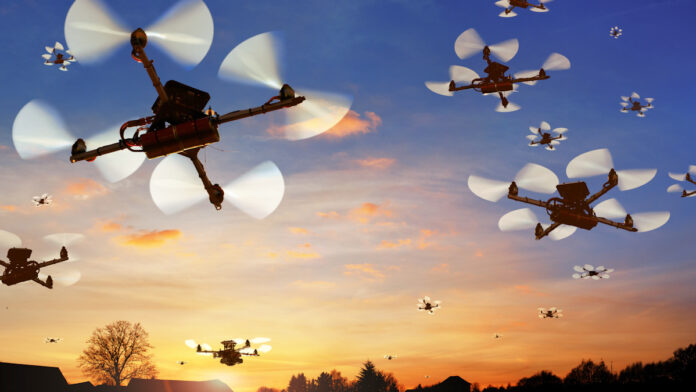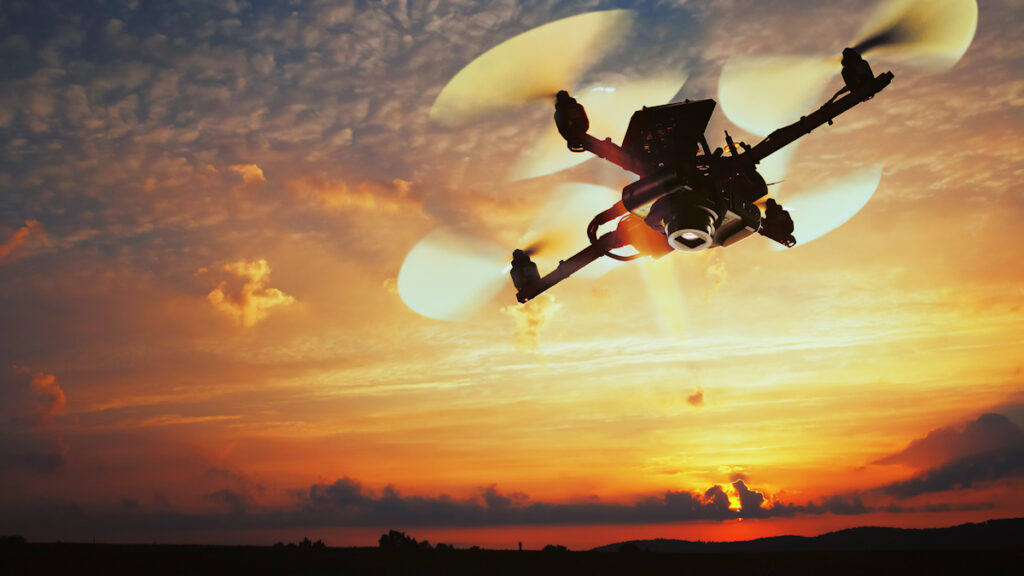Drone Security Predictions Suggest Airspace Growing Perimeter Security Vector.
Drone Security Predictions – Thoughtful security managers have had their eye on the skies in relation to the threat posed by drones for many years, with salient threats and applications including prisons and high security sites, particularly airports.
But recent conflicts in which drones have been deployed to help thwart static perimeter security systems or as delivery mechanisms for explosives, as well as for critical intelligence gathering, continue to highlight the importance of drones to security teams as a major threat and a tool to enhance situational awareness, perimeter detection and first response.
While drones are a threat, the rapid incorporation of enhanced AI into security drones will allow these comparatively inexpensive devices to keep an eye on a wide environment and to report trends and changes, including movement of vehicles and people over time.
Counter drone defence company Dedrone recently released 12 predictions its team believes will impact on the future of drone threat and use in security and law enforcement applications. According to Dedrone, stricter regulations are also on the horizon, though it’s likely these will apply differently when it comes to legitimate security and law enforcement applications.
First off, Dedrone argues that drone swarms will become a standard threat vector. One of the tricky things about drones operating in swarms is that they are far more difficult to disrupt if unprepared, and have the potential to cause considerable harm, not only to infrastructure, but also if directed to attack large scale public events.
Drone Security Predictions
The ability of drones to carry explosive devices considerable distances is proven, making them a serious threat. As is typical in conflict scenarios, Russia’s invasion of Ukraine has led the 2 countries into a drone arms race, with more capable models being built to meet requirements of war – longer flight times, lower cost, greater range, greater carrying capacity, increased carrying flexibility, enhanced stealth, and more.
According to Dedrone, while these developments highlight a threat, they will also drive innovation and investment, as organisations and governments seek to apply the best technology and the best defences. Expanded capabilities are certain to include things like AI and deep learning, with drones able to learn their environment and spot variables and emerging threats, including intruders, floods, fires, other drones, and more.
Emerging from these trends, Dedrone believes critical infrastructure will begin to think more seriously about airspace security. In the recent past there have been encroachments of drones into controlled airspace in multiple countries – the obvious ability of drone to carry weapons now makes this threat much more of a concern.
It’s a tricky area, given the enormous scope of critical infrastructure in any country but key locations will need to be defended and any incident globally is likely to spike this investment.
In the U.S. remote ID is going to be introduced for drones but Dedrone says the initiative has serious shortcomings. Remote ID will simply monitor legitimate users – criminal actors will use various technique to limit or stop remote ID transmissions from their drones. Nor will criminal actors likely be registered drone operators.
Drone Security Predictions
Another emerging trend is going to be drone as first responder, the sort of application Australians see at beaches, were surf patrols use them to keep an eye out for swimmers in trouble and dangerous conditions, including large waves, rips, currents and sharks. Other applications include bushfire spotting, at which they show significant promise.
It’s likely these sorts of applications are going to remain on a comparative short leash, simply because non-military drones are not empowered to undertake autonomous or semi-piloted flights to grid references – but the capability is there and it’s potentially a life saver.
A few other points to note – the U.S. government has released an executive order around AI that will make the influential Department of Defense, Department of Homeland security and other key agencies choosy about partners in applications that concern national security for military or intelligence purposes.
Finally, let’s go back to those regulations. As the threat from more capable drones increases, it’s likely legislation surrounding their use will be tightened and counterdrone technology will become easier for public safety and security professionals to access.
You can read the full Dedrone whitepaper here or read more SEN news here.
“Drone Security Predictions Suggest Airspace Growing Perimeter Security Vector.”












